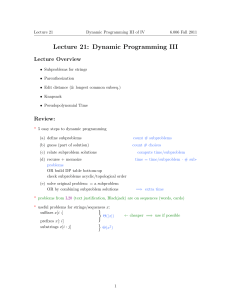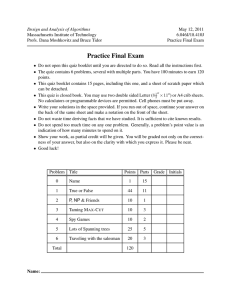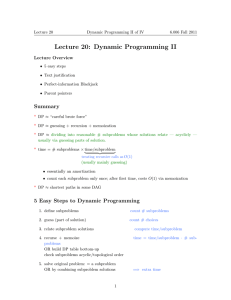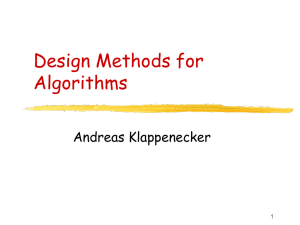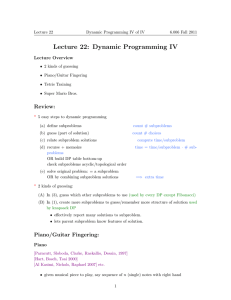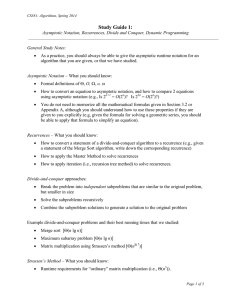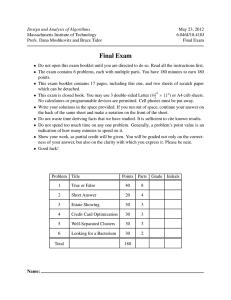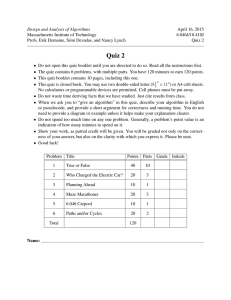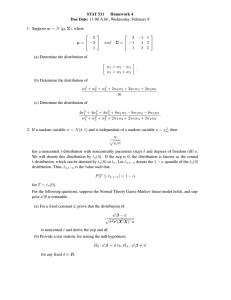Lecture 10: DP notions
advertisement
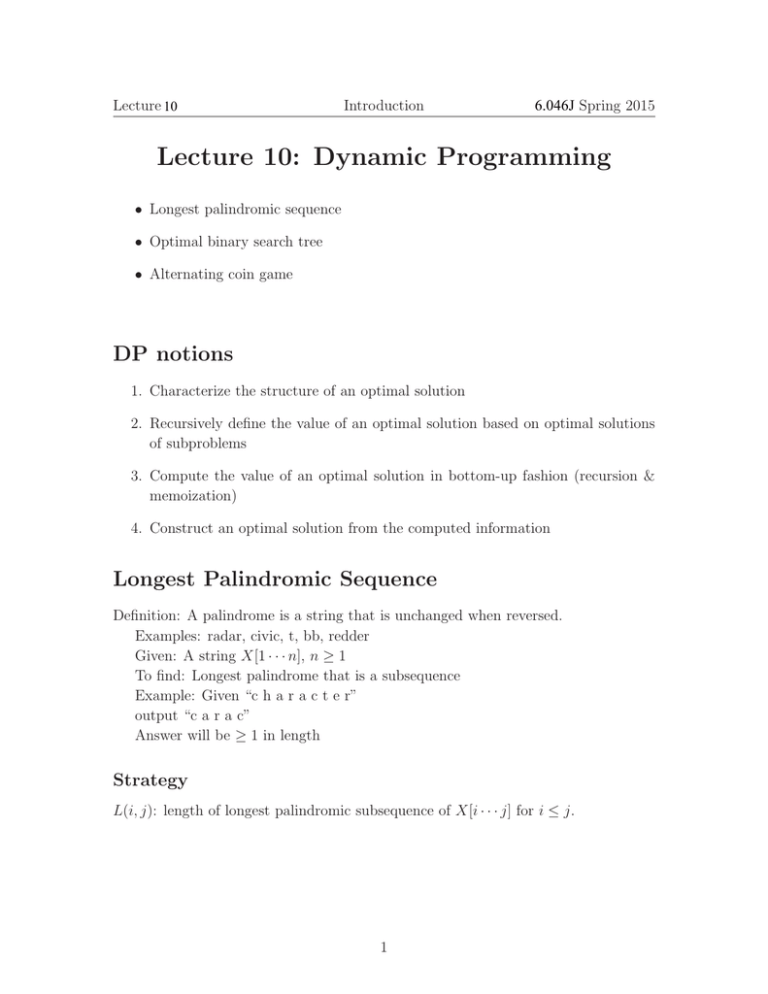
Lecture 10
Introduction
6.046J Spring 2015
Lecture 10: Dynamic Programming
• Longest palindromic sequence
• Optimal binary search tree
• Alternating coin game
DP notions
1. Characterize the structure of an optimal solution
2. Recursively define the value of an optimal solution based on optimal solutions
of subproblems
3. Compute the value of an optimal solution in bottom-up fashion (recursion &
memoization)
4. Construct an optimal solution from the computed information
Longest Palindromic Sequence
Definition: A palindrome is a string that is unchanged when reversed.
Examples: radar, civic, t, bb, redder
Given: A string X[1 · · · n], n ≥ 1
To find: Longest palindrome that is a subsequence
Example: Given “c h a r a c t e r”
output “c a r a c”
Answer will be ≥ 1 in length
Strategy
L(i, j): length of longest palindromic subsequence of X[i · · · j] for i ≤ j.
1
Lecture 10
1
2
3
4
5
6
7
Introduction
6.046J Spring 2015
def L(i, j) :
if i == j: return 1
if X[i] == X[j]:
if i + 1 == j: return 2
else : return 2 + L(i + 1, j - 1)
else :
return max(L(i + 1, j), L(i, j - 1))
Exercise: compute the actual solution
Analysis
As written, program can run in exponential time: suppose all symbols X[i] are dis­
tinct.
T (n) = running time on input of length n
1
n=1
T (n) =
2T (n − 1) n > 1
n−1
=2
Subproblems
n
= θ(n2 ) distinct subproblems: each is an (i, j) pair with
2
i < j. By solving each subproblem only once. running time reduces to
But there are only
θ(n2 ) · θ(1) = θ(n2 )
where θ(n2 ) is the number of subproblems and θ(1) is the time to solve each
subproblem, given that smaller ones are solved.
Memoize L(i, j), hash inputs to get output value, and lookup hash table to see if
the subproblem is already solved, else recurse.
Memoizing Vs. Iterating
1. Memoizing uses a dictionary for L(i, j) where value of L is looked up by using
i, j as a key. Could just use a 2-D array here where null entries signify that the
problem has not yet been solved.
2. Can solve subproblems in order of increasing j − i so smaller ones are solved
first.
2
Lecture 10
6.046J Spring 2015
Introduction
Optimal Binary Search Trees: CLRS 15.5
Given: keys K1 , K2 , · · · , Kn , K1 < K2 < · · · < Kn , WLOG Ki = i
weights W1 , W2 , · · · , Wn
Find: BST T that minimizes:
n
L
Wi · (depthT (Ki ) + 1)
i=1
Example: Wi = pi = probability of searching for Ki
Then, we are minimizing expected search cost.
(say we are representing an English → French dictionary and common words
should have greater weight)
Enumeration
Exponentially many trees
2
1
n = 2
2
1
W1 + 2W2
3
3
n = 3
2
1
3W1 + 2W2 + W3
2W1 + W2
1
1
3
3
2
2W1 + 3W2 + W3
1
1
2
2
2W1 + W2 + 2W3
W1 + 3W2 + 2W3
Strategy
W (i, j) = Wi + Wi+1 + · · · + Wj
e(i, j) = cost of optimal BST on Ki , Ki+1 , · · · , Kj
Want e(1, n)
Greedy solution?
Pick Kr in some greedy fashion, e.g., Wr is maximum.
greedy doesn’t work, see example at the end of the notes.
3
2
3
W1 + 2W2 + 3W3
Lecture 10
Introduction
6.046J Spring 2015
Kr
keys Kr+1,…, Kj
e(r+1, j)
keys Ki,…, Kr-1
e(i, r-1)
DP Strategy: Guess all roots
e(i, j) =
⎧
⎨ Wi
if i = j
⎩ min (e(i, r − 1) + e(r + 1, j) + W (i, j)) else
i≤r≤j
+W (i, j) accounts for Wr of root Kr as well as the increase in depth by 1 of all
the other keys in the subtrees of Kr (DP tries all ways of making local choices and
takes advantage of overlapping subproblems)
Complexity: θ(n2 ) · θ(n) = θ(n3 )
where θ(n2 ) is the number of subproblems and θ(n) is the time per subproblem.
Alternating Coin Game
Row of n coins of values V1 , · · · , Vn , n is even. In each turn, a player selects either
the first or last coin from the row, removes it permanently, and receives the value of
the coin.
Question
Can the first player always win?
Try: 4 42 39 17 25 6
Strategy
V1 , V2 , · · · , Vn−1 , Vn
1. Compare V1 + V3 + · · · + Vn−1 against V2 + V4 + · · · + Vn and pick whichever is
greater.
2. During the game only pick from the chosen subset (you will always be able to!)
How to maximize the amount of money won assuming you move first?
4
Lecture 10
Introduction
6.046J Spring 2015
Optimal Strategy
V (i, j): max value we can definitely win if it is our turn and only coins Vi , · · · , Vj
remain.
V (i, i) : just pick i.
V (i, i + 1): pick the maximum of the two.
V (i, i + 2), V (i, i + 3), · · ·
V (i, j) = max{(range becomes (i + 1, j)) + Vi , (range becomes (i, j − 1)) + Vj }
Solution
V (i + 1, j) subproblem with opponent picking
we are guaranteed min{V (i + 1, j − 1), V (i + 2, j)}
Where V (i+1, j−1) corresponds to opponent picking Vj and V (i+2, j) corresponds
to opponent picking Vi+1
We have
V (i, j) = max min
V (i + 1, j − 1),
V (i + 2, j)
+ Vi , min
V (i, j − 2),
V (i + 1, j − 1)
+ Vj
Complexity?
Θ(n2 ) · Θ(1) = Θ(n2 )
Example of Greedy Failing for Optimal BST prob­
lem
Thanks to Nick Davis!
5
Lecture 10
6.046J Spring 2015
Introduction
10
2
8
1
3
1
9
4
Figure 1: cost = 1 × 2 + 10 × 1 + 8 × 2 + 9 × 3 = 55
8
3
9
10
2
4
1
1
Figure 2: cost = 1 × 3 + 10 × 2 + 8 × 1 + 9 × 2 = 49
6
MIT OpenCourseWare
http://ocw.mit.edu
6.046J / 18.410J Design and Analysis of Algorithms
Spring 2015
For information about citing these materials or our Terms of Use, visit: http://ocw.mit.edu/terms.

